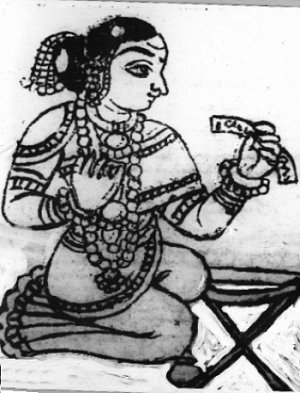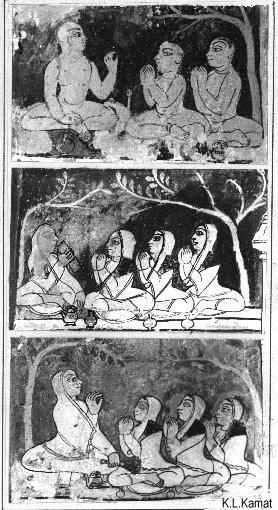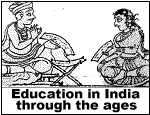Tradition of Female Education in Karnataka
by Dr. Jyostna Kamat
First Online: March 07, 2000
Page Last Updated: December 07, 2024
It is generally believed that women were denied education, particularly in medieval times and later in the British period. Absence of references to female students in traditional educational institutions like agaraharas, mathas and ghatikas further leads to confirm this view. But from ancient times, a regular system of domestic education existed in South India for girls, which continued even up to the nineteenth century. Available information from Kannada Kavyas (epic poetry), sculptures, paintings and depiction in lithographs (printing) provides us glimpses of an unhindered tradition of imparting education to females in reading, writing, arithmetic, recitation from classics, dance, drama; music besides general knowledge about ways of the world. Some observations could be made from the above available sources, starting with general knowledge.
General Knowledge
Domingo Paes and Fernao Nuniz, the Portuguese travelers who visited the Vijayanagar kingdom during sixteenth century, had noticed, participation of women in big number in the Navaratri festival. They sang, danced, played trumpets, drums, violins and pipes. There were women-accountants, guards, wrestlers and fighters! The pictorial education was imparted to the ladies of the palace by illustrating life styles of people around the world on the walls of inner apartment of the Zenana. This method had a great impact on learning of environment, geography and allied subjects. This system continued in the following centuries. Chennabasavapurana, a Kannada literary work of sixteenth century refers to an inner hall of a nobleman decorated with paintings of beasts and birds of different countries. Again "Kanthiravanarasaraja Vijaya" of Govinda Vaidya (1648 A.D.) describes inner apartments of Mysore palace, walls of which were decorated with painting, depicting episodes from Kavyas, Ramayana and Mahabharata. In order to give three dimensional effect, the rooms were provided with life size sculptures of swans, peacocks, elephants, bison and tigers.
The method of painting royal bedrooms with erotic scenes is mentioned in Vikramankabhyudayam of 12th century Chalukya king, Somesvara. Kanthiravanarasarajavijaya also refers to "Madana-vilasa" hall which contained paintings and sculptures depicting Kamasutra. It is very obvious that these were intended to impart sex education to young couples.
Reading and Writing
The existence of a big woman force in the palace is confirmed and their quarters were near those of royalty. Oduva (Reader) Tirumalamma or Tirumalambika used to read out classics and holy texts in the palace. She also excelled in composing poetry in Sanskrit. Because of these talents, she had won admiration from the king Achyutaraya. There were also women who excelled in different sastras, literature, drama and music. This kind of education produced versatile queens who were good scholars and administrators. A herostone of Kolar district of Karnataka depicts an educated girl by name Savinirmadi who was well versed in all Sastras. Sanchiya Honnamma, a betel-server in the Mysore palace got all encouragement from the royalty to study under the famous court scholar, Rajaguru Alahiya Singaraya. Her seventeenth century classic, Hadinadeya Dhama gives numerous sutras or guide lines that could help a woman to lead an ideal housewife's life.

Girl engaged in Self Study
Self-study was as important as attending a classroom teaching. Stress was laid on memorizing, reproduction and correct pronunciation. In numerous paintings and sculptures of Karnataka one comes across many illustrations in which female students are depicted as engrossed in reading and writing.
Recitation from Classics
There were expert women who were engaged in educating and entertaining housewives. Such volunteers were required to be accomplished vocalists, instrumentalists, orators, witty and humorous. They were well-versed in literature and music and therefore could set ragas to selected verses depending upon rasa and bhava of the piece. Sculptures depicting women engaged in recitation by holding palm leaves-book in left hand and playing a string instrument by right hand are a common sight on temple pillars of Karnataka.
Music and Dance
Personal attention was paid to every individual while teaching music and dance. The hall where girls from higher society were trained was known as Kannemada. Paes had seen such a hall in Vijayanagara palace. Each pillar of this hall and paintings depicting different postures of a particular dance which helped the students while practicing. Paes had also seen a painted recess where women clung on with their hands to stretch and loosen their limbs to make their whole bodies supple. He had noticed the golden image of a girl of about twelve years age with her arms in the position which came at the end of dance performance. This age was considered ideal for a student by Sivatattva rathnakara, an anthology in Sanskrit ascribed to king Basavaraja I of Keladi (1684-1710 A.D.) Up to twenty years of age was considered as the best period for performing dance. After thirty years, one has to retire from this art field. A dancer had to be of medium height, weight, proportionate limbs, and a very pleasant personality. She should be adept in music, dance, acting, recitation and also in conversation.
Chalukya and Hoysala queens and princesses were accomplished musicians and dancers and had title like, Ganasarade, Patrajagaddale and Geetavadyanataka-Sutradhari. Sixteenth century Portuguese traveler, Barbosa, had noticed that the service-wing of the palace recruited talented young girls after scouting through the entire kingdom. The courtesans were the custodians of fine art of the palace as well as the empire. Hyder Ali (see also: Tippu Sultan) kept up this practice of recruiting pretty girls from Lahore, Abdala, Kabul, Kandhar, Kashmir, Gujarat, Arabastan etc., and got them trained in dance, singing, playing musical instruments, and acting. Their training was supervised by the father of Manager Kuppayya, who was an authority on Bharatanatya-sastra and was the head of the royal theater.

Jain Painting shows education of Nuns and Monks
While the Buddhists hesitated in accepting bhikshunis (nuns) to the clergy (Sangha), Jains welcomed sanyaninis from the very beginning. At Tapogachha campus in Gujarat, the ladies were educated in many fields. They were especially trained to be teachers and messengers of philosophy. They participated in religious discussions and exchange of ideas which was inherent to the mode of education. The pictures above, taken from a Jain muth in Shravanabelagola, show education of Jain monks and nuns.
Education of Commoners
In Jain monasteries and muthas, spiritual training of nuns continued and was kept unhampered by the wandering mendicants. Basadis continued to impart popular education for women where shravaka goshthis were conducted. They learnt to read Jinagamas, participated in group singing of stotras and listened to stories of Trishashthi-Salaka purushas. Temples also played a similar role in female education. Housewives of Purandardasa's period (16th century) were adept in handling musical instruments like tittiri, mouri, tanpura, cymblas etc., and were busy giving performances during festival occasions. Obviously they had their own method of learning at home under accomplished housewives.
Existence of literacy to a fair degree among women is confirmed by copies of palm-leaf manuscripts available even today that were copied by women. Popular works like Kumara Ramana Sangatya, Basava purana, Sukumaracharite, Linga lilavilasa were copied down by women who and carried out this tedious work for self study or to help others in reading. Tulu folklore speaks of a girl student who tried copying letters on sand and memorize lessons.
References
- This page is adapted for the Web. See the original research paper in India Index with recitations and references.
- References and Pointers to further study
|
||||||
|
|
|
|||||
| Kamat's
Potpourri |
||||||
Merchandise and Link Suggestions
- Advertise Your Website Here -- For as little as a buck-a-day
- Explore More: education kar, female education, s education, tradition

